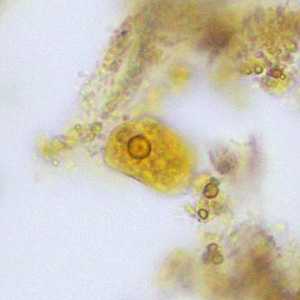
Case #376 - July 2014
A state health laboratory received stool specimens collected in in sodium acetate-acetic acid-formalin (SAF) for ova-and-parasite (O&P) examination. The patient was an immigrant, but his specific country of origin was not known. The stool was processed by formalin-ethyl acetate (FEA) concentration and trichrome staining. The attending microbiologist observed what she believed to be trophozoites of an Entamoeba species in both the wet mount from the FEA and the trichrome-stained smear; no cysts were observed. Digital images of the suspect amoebae were captured and sent to the DPDx Team for diagnostic assistance. Figure A shows what was observed in an unstained wet mount of the FEA concentrate; Figure B is also from the wet mount, but stained with iodine. Figures C and D show what was observed on the trichrome-stained slide. The objects ranged from 14-25 μm in length. What is your diagnosis? Based on what criteria? What other testing, if any, would you recommend?

Figure A

Figure B

Figure C

Figure D
Case Answer
These images showed trophozoites of Entamoeba histolytica/dispar. Diagnostic morphologic features included:
- trophozoites within the size range of Entamoeba histolytica/dispar (Figures A-D).
- a single nucleus with evenly-distributed peripheral chromatin and a discrete karyosome that is centrally (or slightly eccentrically) located (Figures A-D).
Because ingested erythrocytes were not observed in any of the trophozoites, Entamoeba histolytica could not be confirmed. Normally, PCR would be recommended for a species-level identification, but because the specimen was preserved in SAF molecular testing was not performed. The concentration of formalin in SAF makes it an unfavorable preservative for molecular testing.
More on: amebiasis
Images presented in the monthly case studies are from specimens submitted for diagnosis or archiving. On rare occasions, clinical histories given may be partly fictitious.
DPDx is an education resource designed for health professionals and laboratory scientists. For an overview including prevention and control visit www.cdc.gov/parasites/.
- Page last reviewed: August 24, 2016
- Page last updated: August 24, 2016
- Content source:
- Global Health – Division of Parasitic Diseases and Malaria
- Notice: Linking to a non-federal site does not constitute an endorsement by HHS, CDC or any of its employees of the sponsors or the information and products presented on the site.
- Maintained By:


 ShareCompartir
ShareCompartir